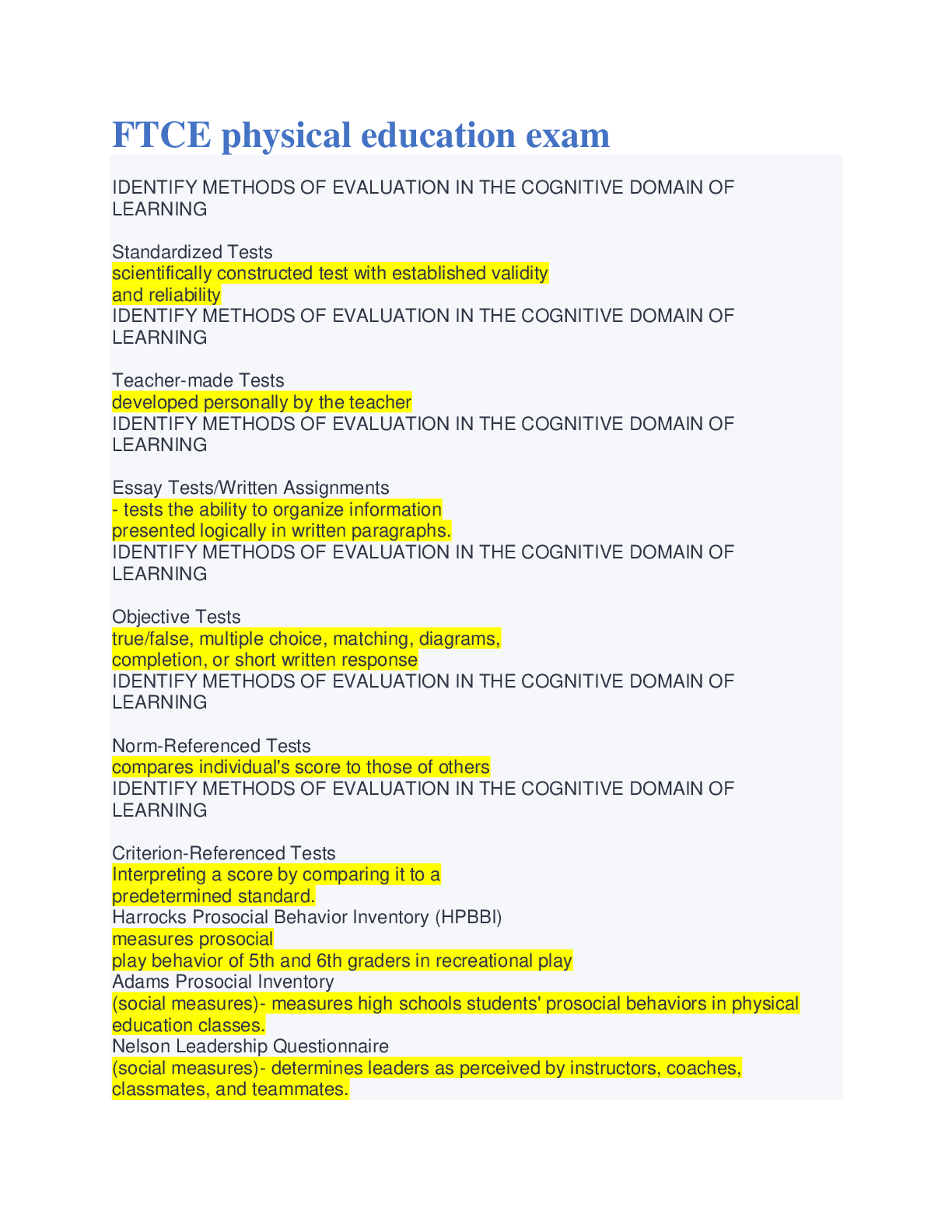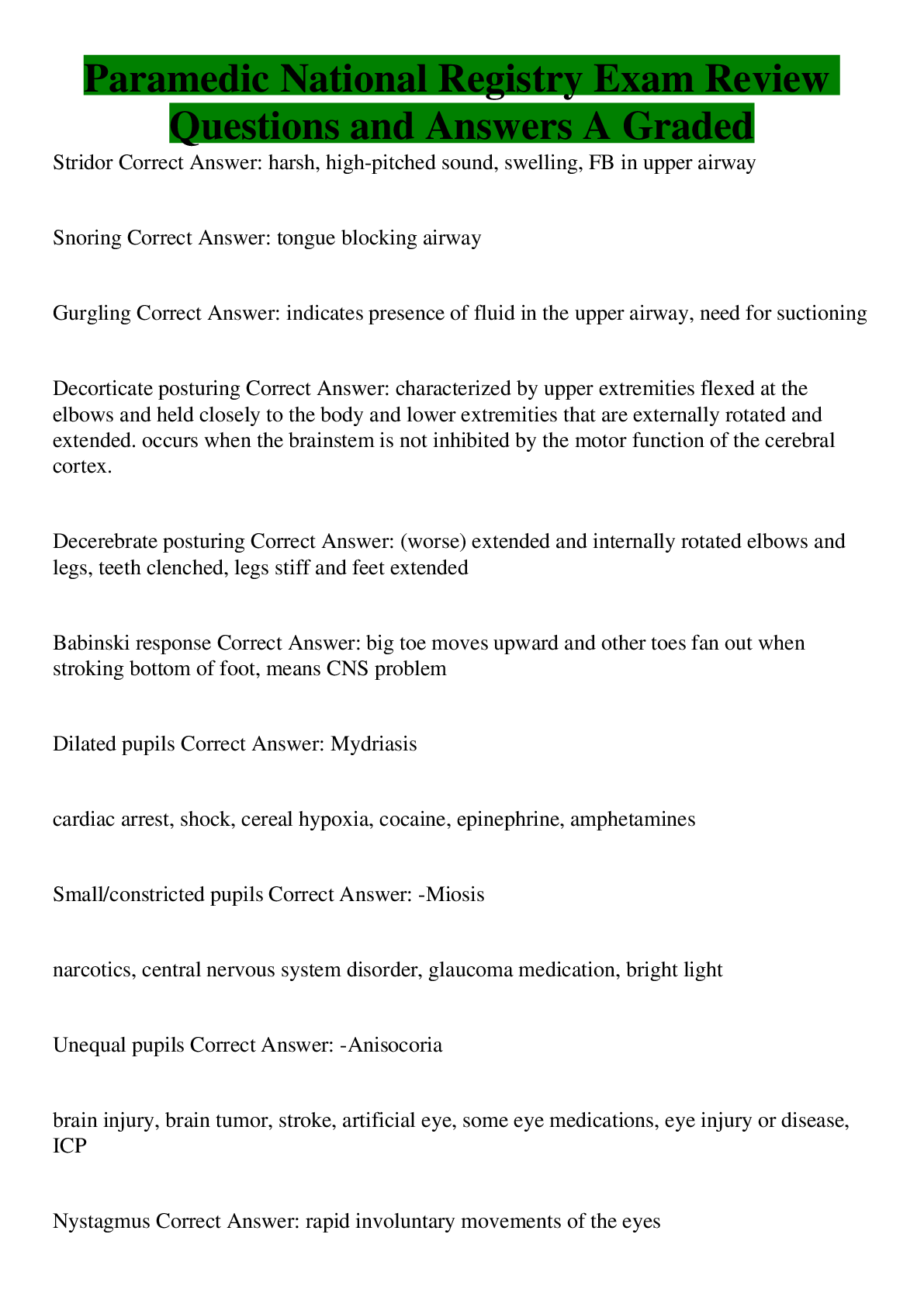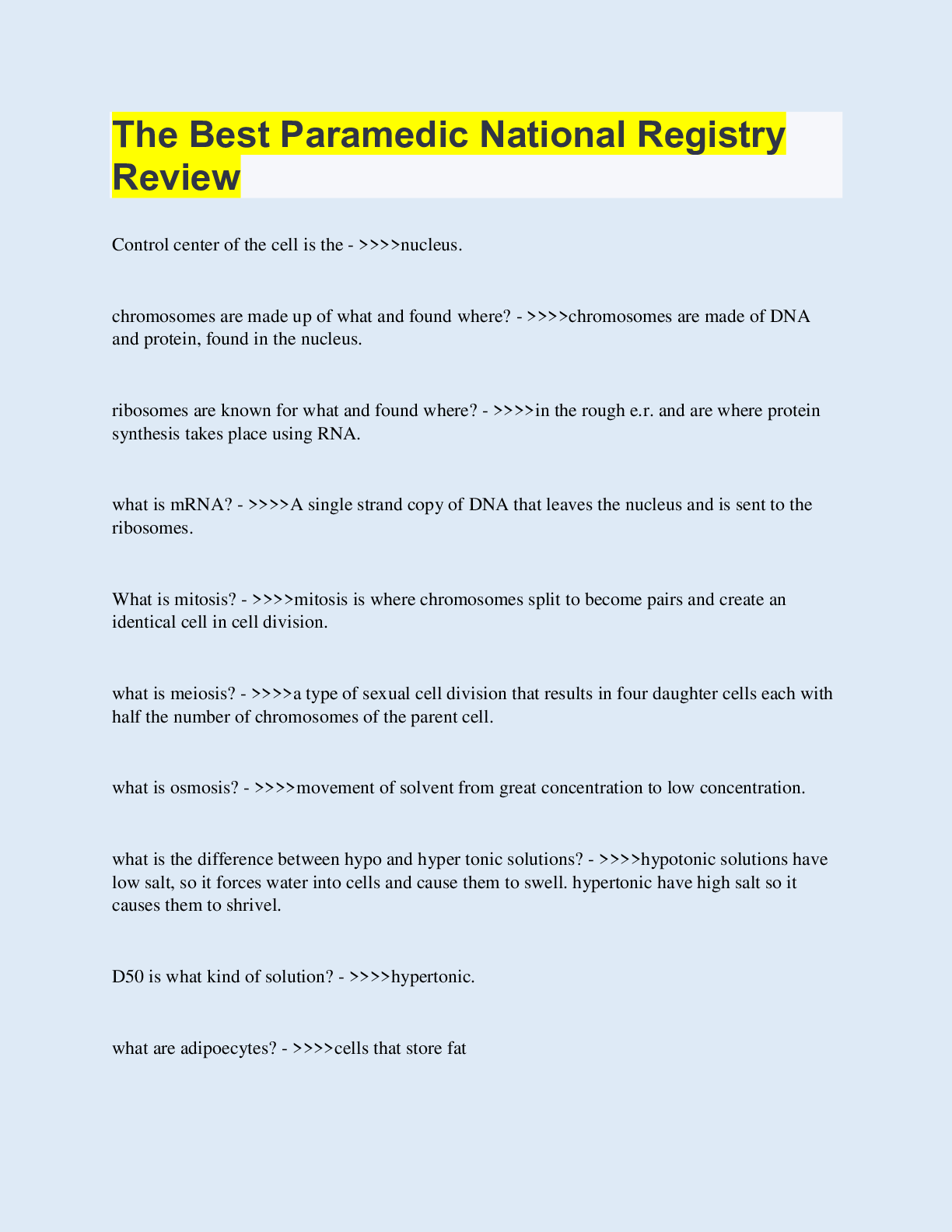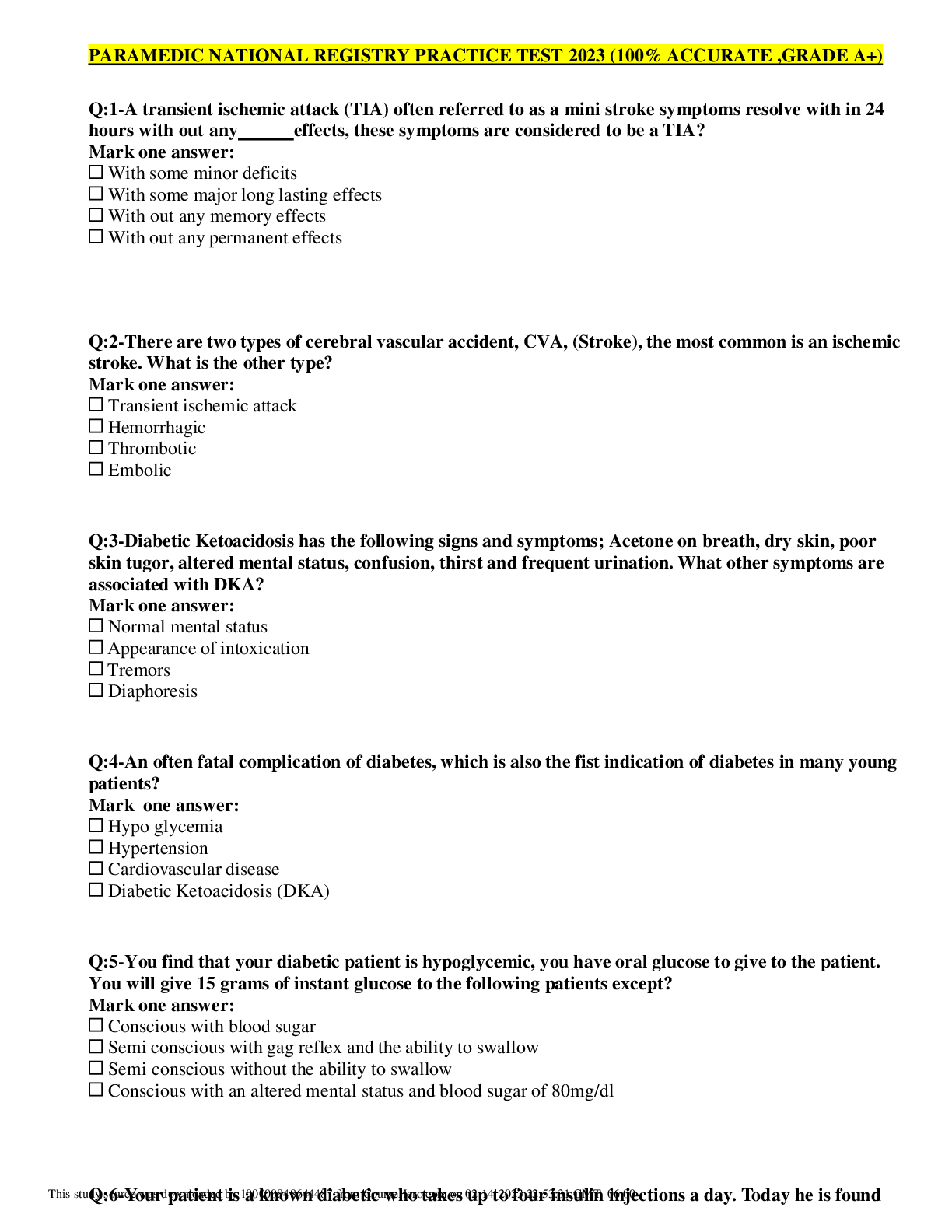Health Care > EXAM > The Best Paramedic National Registry Review (FOR AUDIO USE) (All)
The Best Paramedic National Registry Review (FOR AUDIO USE)
Document Content and Description Below
Control center of the cell is the Correct Answer: nucleus. chromosomes are made up of what and found where? Correct Answer: chromosomes are made of DNA and protein, found in the nucleus. ribos... omes are known for what and found where? Correct Answer: in the rough e.r. and are where protein synthesis takes place using RNA. what is mRNA? Correct Answer: A single strand copy of DNA that leaves the nucleus and is sent to the ribosomes. What is mitosis? Correct Answer: mitosis is where chromosomes split to become pairs and create an identical cell in cell division. what is meiosis? Correct Answer: a type of sexual cell division that results in four daughter cells each with half the number of chromosomes of the parent cell. what is osmosis? Correct Answer: movement of solvent from great concentration to low concentration. what is the difference between hypo and hyper tonic solutions? Correct Answer: hypotonic solutions have low salt, so it forces water into cells and cause them to swell. hypertonic have high salt so it causes them to shrivel. D50 is what kind of solution? Correct Answer: hypertonic. what are adipoecytes? Correct Answer: cells that store fat What are endocrine glands? Correct Answer: ductless glands that secrete hormones into capillaries. examples of endocrine glands are: pituitary, thyroid, parathyroid, adrenal, and pineal. what are exocrine glands? Correct Answer: glands with ducts that secret fluids away from site of function. (ex: sweat, saliva, etc.) what is keratin? Correct Answer: a "waterproof" protein used in the integumentary system. What is the stratum corneum? Correct Answer: outermost layer of epidermis what is the stratum granulosum? Correct Answer: The the stratum granulosum, also called the Granular layer, is very thin, Just below the outer most layer of skin. This is where keratin and lamellated granuoles accumulate. what are sebaceous glands? Correct Answer: Sebaceous glands are glands that open into hair follicles, or directly onto surface. What are ceruminous glands? Correct Answer: Modified sweat glands found only in auditory canal. What are apocrine glands? Correct Answer: Mainly in the armpits and the groin area. Contains bit of cytoplasm from the secreting cells. The cell debris attracts bacteria. what organ in the GI tract contains both exocrine and endocrine glands? Correct Answer: the pancreas What are the islets of Langerhans? Correct Answer: cells in the pancreas that produce insulin. Islets of Langerhans are beta cells. what are alpha cells in the pancreas? Correct Answer: produce glucagon to stimulate liver to make glucose. Just think, alpha cells do the work. Alpha cells stimulate the liver. what are beta cells in the pancreas? Correct Answer: produce insulin that transports glucose from blood straight into the cells by increasing permeability. what does P.T.H. stand for and what does it do? Correct Answer: parathyroid hormone, important for the maintenance of calcium and phosphate levels in blood. where is parathyroid hormone created? Correct Answer: parathyroid gland how does PTH increase Calcium absorption while lowering phosphate in blood? Correct Answer: PTH stimulates activation of vitamin D in the kidneys to reabsorb Calcium and excrete phosphate. What does calcitonin do and where is it produced? Correct Answer: Calcitonin is produced in the thyroid gland. It decreases blood calcium levels by stimulated calcium absorption in bones. What does the adrenal medulla secrete? Correct Answer: catecholamines and sym-path-o-mimetics, A.K.A. epinephrine and norepinephrine. what originally stimulates the adrenal medulla in the adrenal glands? Correct Answer: the hypothalamus stimulates the adrenal gland. what part of the brain controls metabolism and blood temperature? Correct Answer: Hypothalamus how much of cellular respiration is energy and how much is heat? Correct Answer: throughout the whole process of cellular respiration, only 40% is usable energy, while 60% is heat. how much of the body's heat is produced by the liver and skeletal muscle? Correct Answer: 20% what is the normal body temperature range? Correct Answer: 96.5 - 99.5 Fahrenheit. (36 to 38 Celsius) what is the process of conduction? Correct Answer: heat is transferred from hot object to cool object through direct touching. what is the process of radiation? Correct Answer: heat is directly transferred from one object to another without touching and without heating an environment. what is positive feedback loop? Correct Answer: The uncommon feedback loop that is also involved in normal function. Stimulated when a strange change is detected, such as a fever, contractions during labor, or blood clotting. a positive feedback is not stopped until the change stimulus is externally broken or resolved. what is a negative feedback loop? Correct Answer: Negative feedback loop, is system that contains its own brake or control system, such as shivering or sweating dependent on external temperatures. What is the alimentary canal? Correct Answer: the whole digestive track in which food passes through the body from mouth to anus. includes: esophagus, stomach, and intestines. what are the accessory organs? Correct Answer: accessory organs are organs not in the alimentary canal. these are: liver, pancreas, and gallbladder. where is the duodenum? Correct Answer: first part of the small intestine that sucks in bile from the gallbladder to break down fats. just think: both the small intestine and the gallbladder are a "duo" wearing denum. how long do red blood cells live for? Correct Answer: 120 days Which cells do not have a nucleus? Correct Answer: red blood cells do not have a nucleus. Where are red blood cells produced? Correct Answer: bone marrow which blood type is the universal donor carrying ZERO foreign antigens? Correct Answer: Oh-positive. which blood type is the universal receiver carrying both A and B antigens? Correct Answer: A.B. what is stroke volume? Correct Answer: the amount of blood ejected in one contraction. what is cardiac o [Show More]
Last updated: 2 years ago
Preview 1 out of 36 pages

Buy this document to get the full access instantly
Instant Download Access after purchase
Buy NowInstant download
We Accept:

Reviews( 0 )
$13.50
Can't find what you want? Try our AI powered Search
Document information
Connected school, study & course
About the document
Uploaded On
Sep 12, 2022
Number of pages
36
Written in
Additional information
This document has been written for:
Uploaded
Sep 12, 2022
Downloads
0
Views
84























